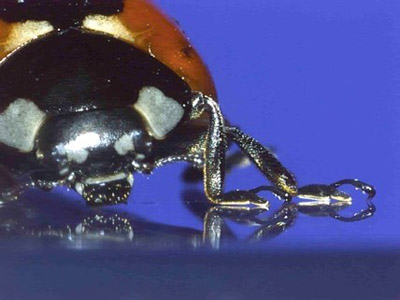Tarsal Adhesion Mechanisms of Ladybird Beetles Ascertained
—40-Year-Old Debate Ended—
2021.06.03
National Institute for Materials Science (NIMS)
NIMS, the University of Tokyo and the University of Kiel have jointly ascertained the tarsal adhesion mechanisms employed by ladybird beetles, which had been debated for decades.
Abstract
- NIMS, the University of Tokyo and the University of Kiel have jointly ascertained the tarsal adhesion mechanisms employed by ladybird beetles, which had been debated for decades.
- Strong adhesives are commonly used to firmly bond materials together. Their use hinders recycling—one of our efforts to build a sustainable society—by making it more difficult to disassemble and sort waste products. Efforts are therefore underway to develop new, environmentally friendly adhesive technologies that have high bonding strength but are also easier to detach. Some scientists in biomimetics have been studying the ability of reptiles and insects to easily walk on ceilings and walls by quickly and repeatedly attaching and detaching their tarsi to and from these surfaces. This research team has been researching and developing new adhesive technologies using the efficient tarsal functions of ladybird beetles as a model. This beetle is capable of walking on glassy, smooth surfaces without slipping despite the fact that the portion of its tarsi which comes into contact with the surface is covered with rigid setae. This portion of the tarsi also secretes fluid. Based on these observations, two potential tarsal adhesion mechanisms had been proposed: a mechanism involving intermolecular forces of attraction between tarsal setae and the walking surface and another mechanism involving the surface tension of the secreted tarsal fluid. The debate over which was correct remained unresolved for 40 years.
- This research team recently succeeded in measuring the thickness of the tarsal fluid layer formed between the setal tips of a ladybird beetle and the glass surface on which the beetle was placed, under the presumption that this thickness indicates the strength of the intermolecular force of attraction between the tarsi and the surface. To make this measurement, the team first formed an AuPd particle layer 10 to 20 nm in thickness on the glass surface. The beetle was then placed on the coated surface and allowed to secrete tarsal fluid. The tarsal fluid was then instantaneously frozen while the beetle’s legs were still resting on the coated surface. The legs were then detached from the surface and the height of the AuPd particle layer filled with the frozen tarsal fluid was measured under a Cryo-SEM microscope. As a result, the thickness of the tarsal fluid layer (i.e., the distance between the setal tips of the beetle and the glass surface) was found to be sufficiently narrow for intermolecular forces of attraction to act effectively. The team then measured traction forces of ladybird beetles walking on the surfaces of various substrates using a combination of biomimetic and materials science techniques in order to determine the relative contributions of intermolecular forces and other adhesion forces. Intermolecular forces are known to be correlated with work of adhesion (WA), the amount of energy required to separate two connected surfaces of different materials. The correlation between WA and traction forces was therefore examined by fitting experimental data into a mathematical formula describing the relationship between these two parameters. As a result, the tarsal adhesion force of the beetle was found to be correlated with WA, indicating that intermolecular forces (i.e., van der Waals forces) are the primary force involved in the tarsal adhesion of ladybird beetles.
- In future studies, the team plans to apply these results to the development of artificial structures capable of attaching and detaching themselves to and from various substrates. These structures may be used in the feet of disaster relief robots capable of traveling on various surfaces in a manner similar to ladybird beetles. They also may be integrated into devices designed to replace parts within high-precision equipment.
- This project was carried out by a research team led by Naoe Hosoda (Group Leader, Research Center for Structural Materials, NIMS), Tadatomo Suga (Professor Emeritus, University of Tokyo; currently Professor, Meisei University), Mari Nakamoto (Graduate Student at the University of Tokyo at the time of this research) and Stanislav N. Gorb (Professor, University of Kiel, Germany). This work was supported by the JSPS Grant-in-Aid for Scientific Research (project number: 24120005) and the Innovative Science and Technology Initiative for Security program offered by the Acquisition, Technology & Logistics Agency (grant number: JPJ004596).
- This research was published in the April 8, 2021 issue of Scientific Reports (volume 11, article number 7729).

Figure 1. Ladybird beetle on a glass surface. Its white tarsal setae can be seen in contact with the surface.
Related files
- Research Center for Structural Materials(RCSM)
Contact information
(Regarding this research)
-
Naoe Hosoda
Group Leader
Surface and Adhesion Science Group
Bonding and Manufacturing Field
Research Center for Structural Materials
National Institute for Materials Science
Tel: +81-29-860-4529
E-Mail: Hosoda.Naoe=nims.go.jp
(Please change "=" to "@")
(General information)
-
Public Relations Office
National Institute for Materials Science
Tel: +81-29-859-2026
Fax: +81-29-859-2017
E-Mail: pressrelease=ml.nims.go.jp
(Please change "=" to "@")
Same Keywords
-
Low-Cost, Fly Footpad-Like Adhesive Structure Capable of Repeated Attachment/Detachment
(attachment,detachment)
2020.06.11
-
Recyclable Photoreactive Adhesive
(adhesion)
2023.06.14
-
Fatigue Cracking Mechanism in Metals Revealed through High-Resolution Three-Dimensional Imaging of Large-Volume Samples
(mechanism)
2022.10.28
Recent Press Release
-
Simultaneous Imaging of Intracellular DNA and RNA Using Harmless Light
2025.10.27
-
Development of an AI Device Using Ion Gel and Graphene That Dramatically Streamlines Machine Learning Computations
2025.10.14
-
Demonstrating a Novel Method to Modulate Heat Flow Through the Collective Motion of Spins
2025.10.06
